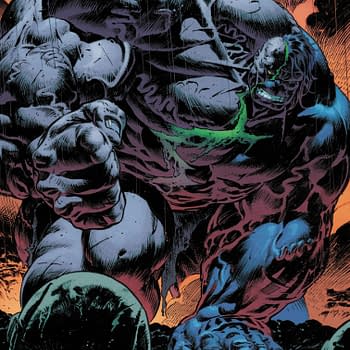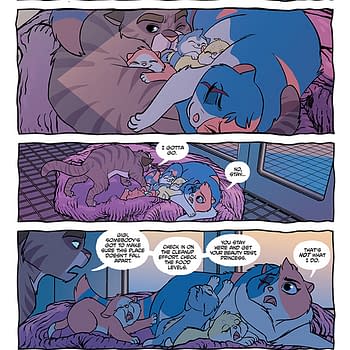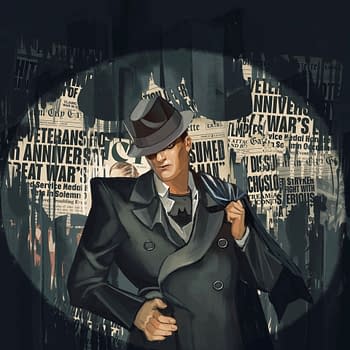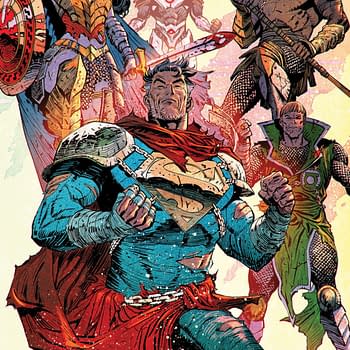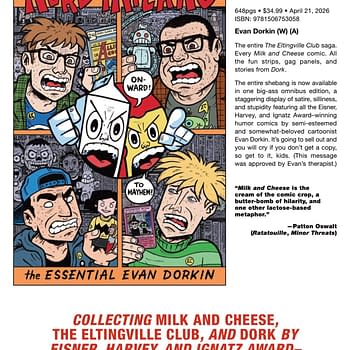Posted in: Comics, Recent Updates | Tagged: Chris Hutchins, Comics, entertainment, Hamlet Max, Hillary Bauman, Jacob Sidney, manga, shakespeare, theater
Shakespeare Meets A Post-Apocalyptic Manga World In Hamlet Max Theater Performance
By Michele Brittany, a West Coast Bleeding Cool Correspondent
The 75-seat Schkapf and Sacred Fools Theater in Los Angeles is hosting a limited run of William Shakespeare's Hamlet. Presented by Central City, theatre actor Jacob Sidney directed Hamlet Max, which he adapted from Shakespeare's Second Quarto. The eight-member cast portrayed 16 different parts with minimal costume changes (costume choices that recycle modern clothing as a facsimile to the period) and props in the 90-minute play. It was a structure I thought worked well and spotlighted the superb performance of each actor. However, in my mind, Sidney's choice of backdrops is what sets his production apart.
The opening voiceover narrative accompanied by sparsely projected manga style panels on the backdrop screen created a post-apocalyptic atmosphere. Sidney's interpretation of Hamlet's arrival in Denmark after a twenty-year absence as being both alive and dead, reminded him of the masterless samurai, the Japanese Ronin archetype. "From this interpretation of the character, I thought about the spare, B&W manga artistic style, specifically the Crying Freeman series released in the US in the early 90s. Although that's a present-day Yakuza story, I felt the tone and mood of the artwork would support the 'mise en scene' I wanted for Hamlet Max. Additionally, I thought the simple elegance of the style would support the story being told by the actors without overwhelming it," Sidney said.
Sidney posted a job announcement for an artist who could create original manga art. Artist Hillary Bauman had experience with creating theatre production sets as well as comic book art. She applied for the job because, "I've been working in the purely inked style for my recent work on 'and…All That Jazz' so this was actually great practice for me in the inked, graphic style of Frank Miller," Bauman acknowledged.
Her crossover work between theatre and comics is what solidified Bauman's position on the production crew. "Her portfolio showed a sensibility toward a kind of stylistic efficiency that I wanted, as well as a refined creativity for creating worlds that are clearly different from our own, but recognizable enough for the viewer to readily accept as real," Sidney said, then added, "I could not have dreamed up a better collaborator."
Bauman and Sidney discussed the initial concepts for the background panels and then Bauman researched various architectural styles for inspiration and to develop her vision for Hamlet Max. She described her style as "heavy shadows, strong lines, burnt structures, cracked cement and the overall feeling that this was a once artistic bustling world that had seen death and devastation." The haunting panels lent to the post apocalyptic setting Sidney envisioned. In addition, using projection backdrops had a functional component as well: with a limited crew, the small amount of equipment could be quickly set up and taken back apart.
Bauman completed her panels on Bristol 11 x 14 paper using black inks. Her renderings included "grayscale layers and cloud cover, the stills of Hamlet's Ghost, Ophelia's drowning and animatic set ups for the Pirate Ship attack on Hamlet and the feeding of Polonius to the pigs. That last one was super fun..I have issues," Bauman chucked.
"The 'specialty' animated sequences (ie the pirate attack) began with Chris [Hutchings, Animation] suggesting storyboard images, which Hillary then created, and Chris assembled into a tight, action sequence. Each of these files was then transferred to Video Designer Mike Rainey, who put them into video cueing software that could then crossfade, pause, etc.," explained Sidney. What resulted were subtle movements on Bauman's projected panels that included floating clouds moving across the sky, torches with flickering flames, and curtains that billowed from a gentle breeze. By far, Hamlet's Ghost was the most impressively animated piece of work for the production. Reviews left at the Fringe website after the first performance on Sunday, June 15 included words such as "gorgeous," "incredible" and "beautiful" to describe the visuals.
"Now that I've built a team and figured out the technology, I'm excited to utilize projections in a wide variety of plays," Sidney revealed. He expressed interest in adapting more of Shakespeare's plays such as Henry V, Richard II, and Julius Caesar, John Webster's The Duchess of Malfi, and for something a bit more modern, Thorne Smith's novella The Nightlife of the Gods. Excitedly Sidney added, "Nearly every one of these has a ghost!" And, if Bauman had her way, she would have "this style for almost every theater production I work on."
In Hamlet Max, Sidney's vision of a stark, haunted Denmark is realized through the projected and animated manga-style panels created by Bauman. The concept works well in conjunction with the minimalist approach to costumes, props, and the number of actors. The modern art style married to a theatrical classic provides audiences a fresh interpretation to Shakespeare, and has potential for future productions.
Production Stills by Kim Gottlieb-Walker.
Michele Brittany is an independent popular culture scholar and semi-professional photographer currently editing an upcoming anthology on the influence of James Bond on popular culture. She regularly posts reviews and analysis on the spy/espionage genre on her blog, Spyfi & Superspies.
















